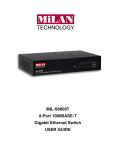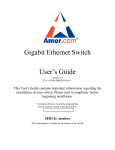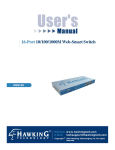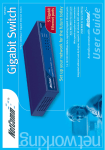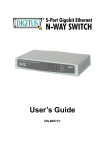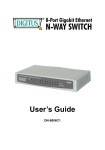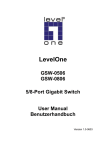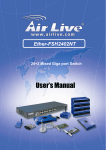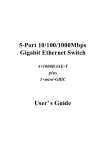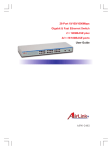Download MiLAN MIL-S16000T User guide
Transcript
MIL-S16000T 16-Port 1000BASE-T Gigabit Ethernet Switch USER GUIDE Regulatory Approval - FCC Class A - UL 1950 - CSA C22.2 No. 950 - EN60950 - CE - EN55022 Class A - EN55024 Canadian EMI Notice This Class A digital apparatus meets all the requirements of the Canadian Interference-Causing Equipment Regulations. Cet appareil numerique de la classe A respecte toutes les exigences du Reglement sur le materiel brouilleur du Canada. European Notice Products with the CE Marking comply with both the EMC Directive (89/336/EEC) and the Low Voltage Directive (73/23/EEC) issued by the Commission of the European Community Compliance with these directives imply conformity to the following European Norms: EN55022 (CISPR 22) - Radio Frequency Interference EN61000-X - Electromagnetic Immunity EN60950 (IEC950) - Product Safety Five-Year Limited Warranty MiLAN Technology warrants to the original consumer or purchaser that each of it's products, and all components thereof, will be free from defects in material and/or workmanship for a period of five years from the original factory shipment date. Any warranty hereunder is extended to the original consumer or purchaser and is not assignable. MiLAN Technology makes no express or implied warranties including, but not limited to, any implied warranty of merchantability or fitness for a particular purpose, except as expressly set forth in this warranty. In no event shall MiLAN Technology be liable for incidental or consequential damages, costs, or expenses arising out of or in connection with the performance of the product delivered hereunder. MiLAN Technology will in no case cover damages arising out of the product being used in a negligent fashion or manner. Trademarks The MiLAN logo and MiLAN Technology trademarks are registered trademarks of MiLAN Technology in the United States and/or other countries. To Contact MiLAN Technology For prompt response when calling for service information, have the following information ready: - Product serial number and revision - Date of purchase - Vendor or place of purchase You can reach MiLAN Technology technical support at: E-mail: [email protected] Telephone: +1.408.744.2751 Fax: +1.408.744.2771 MiLAN Technology 1329 Moffett Park Drive Sunnyvale, CA 94089 United States of America Telephone: +1.408.744.2775 Fax: +1.408.744.2793 http://www.milan.com [email protected] © Copyright 2004 MiLAN Technology P/N: 90000425 Rev. A Table of Contents 1. Introduction Gigabit Ethernet Technology Switching Technology Features Package Contents 2. Hardware Description Front Panel Rear Panel LED Indicators 3. Hardware Installation Desktop Installation Rack mounted Installation Power On 4. Technical Specifications General Specifications Physical and Environmental Specifications Performance Specifications Appendix A: Regulatory Information 1. Introduction Gigabit Ethernet Technology Gigabit Ethernet is an extension of IEEE 802.3 Ethernet utilizing the same packet structure, format, and support for CSMA/CD protocol, full duplex, flow control, and management objects, but with a tenfold increase in theoretical throughput over 100-Mbps Fast Ethernet and a hundredfold increase over 10-Mbps Ethernet. Since it is compatible with all 10-Mbps and 100-Mbps Ethernet environments, Gigabit Ethernet provides a straightforward upgrade without wasting a company’s existing investment in hardware, software, and trained personnel. The increased speed and extra bandwidth offered by Gigabit Ethernet are essential to coping with the network bottlenecks that frequently develop as computers and their busses get faster and user applications generate more traffic. Upgrading key components, such as your backbone and servers to Gigabit Ethernet can greatly improve network response times, as well as significantly speed up the traffic between your subnets. Gigabit Ethernet supports video conferencing, complex imaging, and similar data-intensive applications. Likewise, since data transfers occur 10 times faster than Fast Ethernet, servers outfitted with Gigabit Ethernet NIC’s are able to perform 10 times the number of operations in the same amount of time. Switching Technology Another key development pushing the limits of Ethernet technology is in the field of switching technology. A switch bridges Ethernet packets at the MAC address level of the Ethernet protocol transmitting among connected Ethernet or fast Ethernet LAN segments. Switching is a cost-effective way of increasing the total network capacity available 1 to users on a local area network. A switch increases capacity and decreases network loading by making it possible for a local area network to be divided into different segments which do not compete with each other for network transmission capacity, giving a decreased load on each. The switch acts as a high-speed selective bridge between the individual segments. The switch automatically forwards traffic that needs to go from one segment to another, without interfering with any other segments. This allows the total network capacity to be multiplied, while still maintaining the same network cabling and adapter cards. Switching LAN technology is a marked improvement over the previous generation of network bridges, which were characterized by higher latencies. Routers have also been used to segment local area networks, but the cost of a router and the setup and maintenance required make routers relatively impractical. Today’s switches are an ideal solution to most kinds of local area network congestion problems. Features The MIL-S1600T Gigabit Ethernet Switch was designed for easy installation and high performance in an environment where traffic on the network and the number of users increase continuously. 16 1000BASE-T Gigabit Ethernet ports Auto-Negotiation for 10/100/1000Mbps and duplex mode Auto-MDI/MDIX for each port Full/Half duplex transfer mode for 10 and 100Mbps Full duplex transfer mode for 1000Mbps Full wire speed reception and transmission Store-and-Forward switching method IEEE 802.3x flow control for full-duplex mode Integrated address Look-Up Engine, supports 4K absolute MAC addresses Supports 272K Bytes data buffer per device Extensive front-panel diagnostic LEDs 2 Package Contents Unpack the contents of the package and verify them against the checklist below. MIL-S16000T Gigabit Ethernet Switch AC Power Cord Rack Mount Ears Four Adhesive Rubber Feet User's Guide Warranty Card If any item is missing or damaged, please contact your local dealer for service. 3 2. Hardware Description Front Panel The front panel of the Gigabit Ethernet Switch consists of 16 1000BASE-T Gigabit Ethernet ports and the LED Indicators for the unit, which displays the conditions of the Gigabit Ethernet Switch and the status of the network. Figure 2-1. Front Panel view of the MIL-S16000T Gigabit Ethernet Switch Rear Panel The rear panel of the Gigabit Ethernet Switch consists of an AC power connecter and a power switch. Figure 2-2. Rear Panel view of the MIL-S16000T Gigabit Ethernet Switch The AC Power Connector is a three-pronged connector that supports the power cord. Plug the female connector of the provided power cord into this connector, and the male into a power outlet. Supported input voltages range from 100 - 240 VAC at 50/60 Hz. 4 LED Indicators The LED indicators of the Gigabit Ethernet Switch provide a real-time indication of system operating statuses. There are three LED-indicators for each Gigabit Ethernet port and one Power LED for the Unit. Figure 2-3. LED Indicators on the MIL-S16000T Gigabit Ethernet Switch POWER The Power LED indicator is solid green when the Gigabit Ethernet Switch is receiving power. Link/Act The Link/Act LED indicators are solid when there is a secure connection (or link) to the desired port. A blinking LED indicator signifies reception or transmission (i.e. Activity—Act) of data occurring on a port. 1000Mbps The 1000Mbps LED indicators are solid when there is a secure connection (or link) to a 1000Mbps Gigabit Ethernet device at the desired port. 100Mbps The 100Mbps LED indicators are solid when there is a secure connection (or link) to a 100Mbps Fast Ethernet device at the desired port. Note: When the connection (or link) is 10Mbps, both the 1000Mbps and 100Mbps LED indicators are off. 5 3. Hardware Installation Desktop Installation Set the switch on a sufficiently large flat space with a power outlet nearby. The surface where you put your switch should be clean, smooth, level, and sturdy. Provide enough clearance around the switch to allow attachment of cables, power cord and air circulation. Attaching Rubber Feet A. Make sure the mounting surface on the bottom of the Switch is grease and dust free. B. Remove adhesive backing from the rubber feet. C. Apply the rubber feet to each corner on the bottom of the switch. These footpads can prevent the Switch from shock/vibration. Figure 3-1. Attaching Rubber Feet to each corner on the bottom of the Switch 6 Rack-mounted Installation The MIL-S16000T comes with a rack-mounted kit and can be mounted in an EIA standard size, 19-inch rack. The Switch can be placed in a wiring closet with other equipment. Perform the following steps to rack mount the switch: A. Position one bracket to align with the holes on one side of the switch and secure it with the smaller bracket screws. Then attach the remaining bracket to the other side of the Switch. Figure 3-2. Attach mounting brackets with screws B. After attaching both mounting brackets, position the MIL-S16000T in the rack by lining up the holes in the brackets with the appropriate holes on the rack. Secure the Switch to the rack with a screwdriver and the rack-mounting screws. Figure 3-3. Mount the MIL-S16000T in an EIA standard 19-inch Rack Note: For proper ventilation, allow at least 4 inches (10 cm) of clearance on the front and 3.4 inches (8 cm) on the back of the Switch. This is especially important for enclosed rack installation. 7 Power On Connect the power cord to the power socket on the rear panel of the Switch. Connect the other end of the cord to an appropriate power outlet. Press the power On/Off switch to the on position and check the power indicator on the front panel to see if power is properly supplied. 8 4. Technical Specifications General Specifications Standards: Protocol: Data Transfer Rate: Topology: Network Cables: Number of Ports: IEEE 802.3ab 1000BASE-T IEEE 802.3u 100BASE-TX IEEE 802.3 10BASE-T IEEE 802.3x Flow Control CSMA/CD Ethernet: 10Mbps (Half-duplex) 20Mbps (Full-duplex) Fast Ethernet: 100Mbps (Half-duplex) 200Mbps (Full-duplex) Gigabit Ethernet: 2000Mbps (Full-duplex) Star Ethernet: 2-pair UTP Cat. 3,4,5, Unshielded Twisted Pair (UTP )Cable Fast Ethernet: 2-pair UTP Cat. 5, Unshielded Twisted Pair (UTP )Cable Gigabit Ethernet: 4-pair UTP Cat. 5, Unshielded Twisted Pair (UTP )Cable Sixteen (16) 1000BASE-T Gigabit Ethernet ports Physical and Environmental Specifications AC inputs: Power Consumption: Operating Temperature: Storage Temperature: Humidity: Dimensions: Certification: Safety: 100 – 240 VAC Universal, 50/60 Hz 25 watts maximum 0 °C ~ 40°C -10°C ~ 70°C 5% ~ 90% RH, non-condensing 440mm x 210mm x 44 mm (1U), 19 inch rack-mount width FCC Class A, CE Marking Class A, VCCI Class A cUL(1950), CB(IEC60950) 9 Performance Specifications Transmission Method: RAM Buffer: Filtering Address Table: Packet Filtering/Forwarding Rate: MAC Address Learning: Store-and-forward 272K Bytes per device 4K MAC address per device Full wire speed Self-learning, auto-aging 10 Appendix A: Regulatory Information FCC Warning This equipment has been tested and found to comply with the regulations for a Class A digital device, pursuant to Part 15 of the FCC Rules. These limits are designed to provide reasonable protection against harmful interference when the equipment is operated in a commercial environment. This equipment generates, uses, and can radiate radio frequency energy and, if not installed and used in accordance with this user’s guide, may cause harmful interference to radio communications. Operation of this equipment in a residential area is likely to cause harmful interference, in which case the user will be required to correct the interference at their own expense. CE Mark Warning This is a Class A product. In a domestic environment, this product may cause radio interference, in which case the user may be required to take adequate measures. VCCI Warning This is a product of VCCI Class A Compliance. UL Warning a) Elevated Operating Ambient Temperature-If installed in a closed or multi-unit rack assembly, the operating ambient temperature of the rack environment may be greater than room ambient. Therefore, consideration should be given to installing the equipment in an environment compatible with the manufacturer's maximum rated ambient temperature (Tmra). b) Reduced Air Flow- Installation of the equipment in a rack should be such that the amount of air flow required for safe operation of the equipment is not compromised. c) Mechanical Loading-Mounting of the equipment in the rack should be such that a hazardous 11 condition is not achieved due to uneven mechanical loading. d) Circuit Overloading- Consideration should be given to the connection of the equipment to the supply circuit and the effect that overloading of circuits might have on over current protection and supply wiring. Appropriate consideration of equipment nameplate ratings should be used when addressing this concern. e) Reliable Earthing-Reliable earthing of rack-mounted equipment should be maintained. Particular attention should be given to supply connections other than direct connections to the branch circuit (e.g., use of power strips). 12 90000425 Rev A 13
















